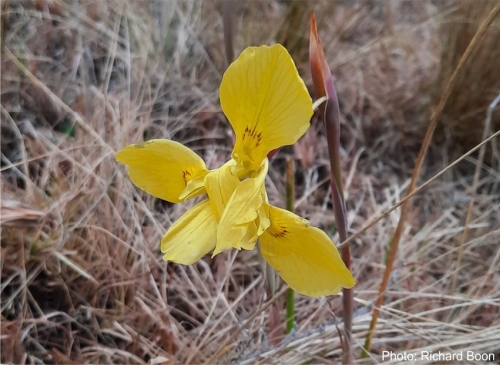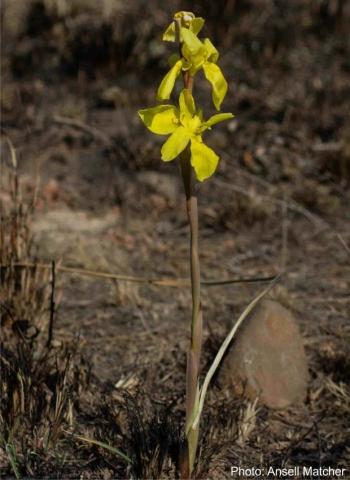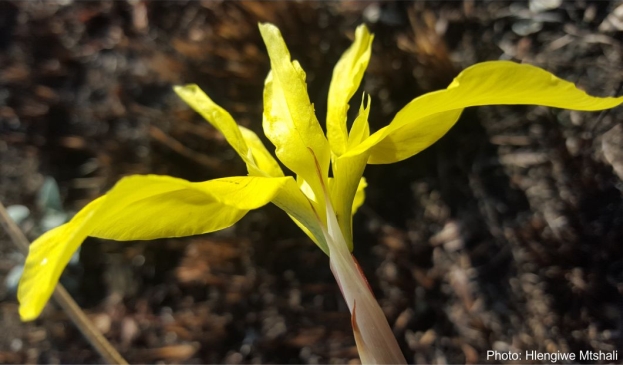Moraea hiemalis
Moraea hiemalis Goldblatt
Family: Iridaceae
Common names: winter yellow moraea
Introduction
A threatened species that is endemic to the grasslands of central KwaZulu-Natal, its striking, rich golden yellow flowers stand out in the winter landscape of this ecosystem.

Description
Description
Moraea hiemalis is a deciduous perennial plant that grows 250–450 mm in height. The rootstock is a corm. Plants are solitary, with a single leaf that is longer than the inflorescence and has tightly inrolled margins so that it appears to be cylindrical (terete) and all that can be seen of the upper (adaxial) surface is no more than a narrow slit or groove. It produces the leaf before the inflorescence and it dies back during the flowering season. The leaves are more green in the lower third. The stem is sheathed with 3-5 overlapping bract leaves.

The flowers are large, golden yellow with dark veins and deep yellow nectar guides, erect inner tepals and broad style branches with conspicuous crests. A plant will produce several flowers in a season. Flowering time is in winter (July and August).

Moraea hiemalis is similar to Moraea spathulata, but can be distinguished by its terete leaf, solitary habit, smaller size and winter flowering time.
Conservation Status
Status
In the Red List of South African Plants 2009 version, Morea hiemalis was assessed NT, Near Threatened, because it has a restricted range and its habitat was being transformed and fragmented by crop cultivation and urban development. In 2015 its status was reassessed as VU, Vulnerable, because increasing urban expansion, habitat degradation through lack of wild fire and invasion by alien plants is causing the species to decline in the wild. Less than half of its habitat remains and the loss continues.

Distribution and habitat
Distribution description
Morea hiemalis is endemic to the central region of KwaZulu-Natal, in the midlands, from Pietermaritzburg and Richmond extending north towards the Drakensberg and Kamberg in the vicinity of Estcourt. Plants are found in mistbelt grassland and in open montane grassland habitats, at 1 000 to 2 000 m altitude and prefer full sun.

Derivation of name and historical aspects
History
The species name hiemalis means ‘of the winter’, referring to Moraea hiemalis being uniquely different from other species in the subgenus Grandiflora by its early flowering time, in winter. In September 1893, Rudolf Schlechter was the first to collect a botanical specimen of Moraea hiemalis, he encountered this plant near Mooi River, KwaZulu-Natal. Before it was named and described by Peter Goldblatt in 1973, in the intervening years, it was regarded as a form of Moraea spathulata.
Moraea has two specific habitats in tropical Africa which could be either dry situations in grassland and open woodland or in wet, marsh situations also known in southern Africa as vleis, and in southern tropical Africa as dambos. Dambos could be seasonal or permanent, but can be distinguished as being not carefully drained, yet rarely deep, and often have a rich vegetation, including many grasses, sedges, as well as geophytes and herbaceous dicots.

Ecology
Ecology
Moraea hiemalis is pollinated by long-tongued bees foraging for nectar.
Uses
Use
Moraea hiemalis can be grown by specialist bulb growers and in grassland gardens and ornamental gardens, because it attracts bees and has aesthetic golden yellow flowers giving a show. It can also be grown as a container plant. There is no record of Moraea hiemalis being used for medicinal or cultural purposes.

Growing Moraea hiemalis
Grow
Moraea hiemalis is not well known in cultivation. It is a summer-growing species and thus can be treated similarly to Moraea spathulata although it is deciduous where Moraea spathulata is evergreen and it thus needs to be kept dry in winter. Sow seeds in spring or early summer. Grow plants in well-drained, humus-rich, acidic soil in a sunny position, with water in spring and summer and a dry winter. They are suitable to be grown in containers.
In general, moraeas are easily grown from seeds, and are best cultivated in a light, well-drained medium and enjoy full sun once fully matured. Sow seeds directly in a well-drained mix, when the plants will experience temperature variations of warm days and cool nights. The winter-growing species are best propagated in autumn, and summer-growing species in are best in spring. According to Dell Sherk of the Pacific Bulb Society, germination could happen within three weeks or may take as long as three years, depending on the species. Most species will require three years to go from seed to flower, but Mary Sue Ittner, of the Pacific Bulb Society has observed Moraea polystachya and Moraea villosa to flower in 1-2 years. Will Ashburner, of the Pacific Bulb Society, recorded germination and flowering time of 12 species as follows: (the first number is weeks to germination and the second is weeks to flowering) Moraea alticola (10, 118), Moraea bellendenii (5, 130), Moraea bubalina (5, 136), Moraea insolens (5, 129), Moraea macronyx (5, 120), Moraea moggii (29, 136), Moraea ramosissima (6, 130), Moraea serpentina (3, 130), Moraea spathulata (6, 135), Moraea thomsonii (6, 128), Moraea tricuspidata (5, 126), Moraea tripetala (3, 121-124).
References
- Boon R. 2022-08-01 Observation of Moraea hiemalis, Indlovu. iNaturalist. Online. https://www.inaturalist.org/observations/132528833.
- Duncan, G. 2010. Grow bulbs. A guide to the cultivation of bulbs of South Africa and neighboring countries. Kirstenbosch Gardening Series. South African National Biodiversity Institute, Cape Town.
- Eliovson, S. 1967. Bulbs for the gardener in the southern hemisphere. Howard Timmins, Cape Town.
- Goldblatt, P. 1989. The moraeas of southern Africa. Annals of Kirstenbosch Botanic Garden Vol. 14. National Botanic Gardens, Cape Town.
- Goldblatt, P. 1973. Contributions to the knowledge of Moraea (Iridaceae) in the summer rainfall region of South Africa. Annals of the Missouri Botanical Garden 60(2):204-259.
- Manning, J., Goldblatt, P. & Snijman, D. 2002. The color encyclopedia of Cape bulbs. Timber Press, Cambridge.
- Matcher, A. 2022-07-20 Observation of Moraea hiemalis, Himeville area, East Griqualand. iNaturalist. Online. https://www.inaturalist.org/observations/131439106.
- Mtshali H. 2015-08-04. Observation of Moraea hiemalis, East Griqualand. iNaturalist. Online. https://www.inaturalist.org/observations/25606720.
- Mtshali, H. & von Staden, L. 2015. Moraea hiemalis Goldblatt. National Assessment: Red List of South African Plants version 2020.1. Accessed on 2022/11/30.
- Pacific Bulb Society, Moraea. https://www.pacificbulbsociety.org/pbswiki/index.php/Moraea. Accessed 9/10/2022.
- Pacific Bulb Society. Moraea Species Five. https://www.pacificbulbsociety.org/pbswiki/index.php/MoraeaSpeciesFive. Accessed 09/10/2022.
- Pienaar, K. & Smith, G.F. 2011. The southern African what flower is that? An essential guide to garden plants. Struik, Cape Town.
- Pooley, E. 1998. A field guide to wild flowers Kwazulu-Natal and the eastern region. Natal Flora Publications Trust, Durban.
- Raimondo, D., Von Staden, L., Foden, W., Victor, J.E., Helme, N.A., Turner, R.C., Kamundi, D.A. & Manyama, P.A. (eds) 2009. Red list of South African plants. Strelitzia 25. South African National Biodiversity Institute, Pretoria.
- Scott-Shaw, C.R. 1999. Rare and threatened plants of KwaZulu-Natal and neighbouring regions. KwaZulu-Natal Nature Conservation Service, Pietermaritzburg.
Credits
Mlondi Sikhosana & Bongekile Ndlovu
KwaZulu-Natal National Botanical Garden
December 2022
Acknowledgements: the authors thank Hlengiwe Mtshali, Richard Boon and Ansell Matcher for making their images available via iNaturalist.
Plant Attributes:
Plant Type: Bulb
SA Distribution: KwaZulu-Natal
Soil type: Loam
Flowering season: Winter
PH: Acid
Flower colour: Yellow
Aspect: Full Sun
Gardening skill: Average
Special Features:
Horticultural zones








Rate this article
Article well written and informative
Rate this plant
Is this an interesting plant?
Login to add your Comment
Back to topNot registered yet? Click here to register.